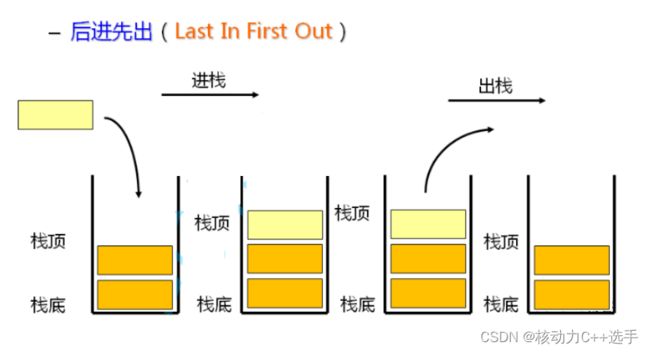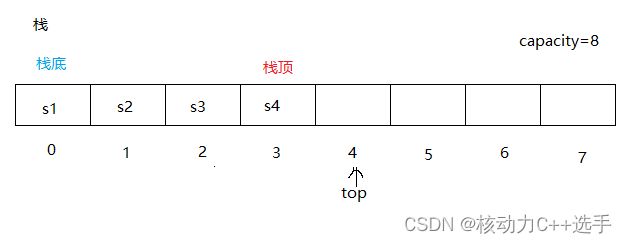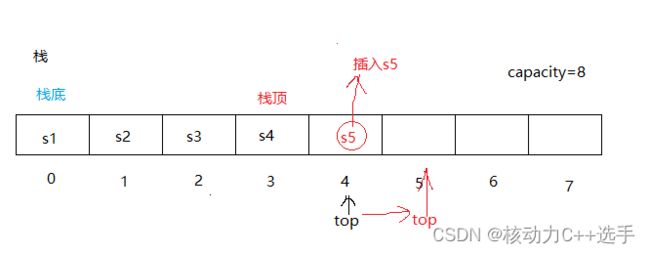数据结构-栈和队列
目录
栈
什么是栈
栈的实现
队列
什么是队列
队列的实现
栈
什么是栈
所谓栈,是一种特殊的线性表,只允许在固定的一端进行插入删除操作。进行数据插入删除的一端叫做栈顶,另一端叫做栈底,栈中的数据遵循先入后出的原则。
压栈:栈的数据插入操作叫做压栈,压栈是在栈顶插入数据。
出栈:栈的数据删除操作叫做出栈。出栈是在栈顶删除数据。
栈的实现
栈的实现一般可以使用数组或者链表实现,相对而言数组的结构实现更优一些。因为数组在尾上插入数据的代价比较小。
接下来我们以数组的方式实现栈。
我们先来用一个结构体定义栈:
typedef struct Stack
{
STDataType* a;
int capacity;
int top;//标识栈顶位置
}ST;其中,a是在堆上开辟数组的地址,capacity表示当前栈的容量,top标识栈顶位置。
接下来,我们设计栈的初始化函数:
void STInit(ST* pst)
{
assert(pst);
pst->a = NULL;
pst->capacity = 0;
//表示指向栈顶元素的下一个位置
pst->top = 0;
//表示top指向栈顶位置
//pst->top = -1;
}需要注意的是,这里的top在初始化时,如果初始化为0,则top指向栈顶的下一个元素;如果初始化为-1,则top指向栈顶元素。
接下来,设计栈的销毁函数,由于栈中的数组元素是在堆上开辟的,因此要进行释放,否则会造成内存泄漏:
void STDestory(ST* pst)
{
assert(pst);
free(pst->a);
pst->a = NULL;
pst->capacity = 0;
pst->top = 0;
}接下来,我们设计栈插入和删除函数:
首先是栈插入函数:
void STPush(ST* pst, STDataType x)
{
assert(pst);
if (pst->capacity == pst->top)
{
int newcapacity = pst->capacity == 0 ? 4 : 2 * pst->capacity;
STDataType* tmp = (STDataType*)realloc(pst->a,newcapacity * sizeof(STDataType));
pst->capacity = newcapacity;
if (tmp == NULL)
{
perror("realloc");
return;
}
pst->a = tmp;
}
pst->a[pst->top] = x;
pst->top++;
}由于我在初始化栈时,top设成0,因此,把待插入的元素x放到数组pst->top的位置,然后pst->top++,指向栈顶的下一个元素。
接着是栈删除函数:
void STPop(ST* pst)
{
assert(pst);
//不为空
assert(pst->top > 0);
pst->top--;
}将top--即可。
接下来,我们设计取栈顶元素函数:
STDataType STTop(ST* pst)
{
assert(pst);
//不为空
assert(pst->top > 0);
return pst->a[pst->top - 1];
}由于pst->top表示栈顶的下一个元素,因此栈顶元素为pst->top-1位置的元素。
接下来设计判断栈是否为空的函数:
bool STEmpty(ST* pst)
{
assert(pst);
return pst->top == 0;
}如果pst->top==0,那么表示栈里没有元素(如果最开始初始化栈时top==-1,那么当pst->top==-1时,才表示栈里没有元素)
接下来设计返回栈元素个数函数:
int STSize(ST* pst)
{
assert(pst);
return pst->top;
}pst->top不但表示栈顶下一个元素,也表示栈中元素的个数。
队列
什么是队列
所谓队列,只允许在一端插入数据,在另一端删除数据,并且具有先进先出的特点。
入队列:进行插入数据的一端称为队尾
出队列:进行删除数据的一端称为队头
队列的实现
考虑到数组在删除队头数据时比较麻烦,因此,我打算基于单向链表实现队列。
对于链表的每一个结点,都有两个成员,一个是val,另一个是指向下一个结点的指针:
typedef int QDataType;
typedef struct QueneNode
{
QDataType val;
struct QueneNode* next;
}QNode;为了便于队列的实现,定义了Quene这个结构体:
typedef struct Quene
{
QNode* phead;
QNode* ptail;
int size;
}Quene;这个结构体维护了一个队列,结构体中的phead和ptail分别指向队列的头尾,同时size记录队列的长度,以便在需要时可以知道此时队列的长度。
在main函数中,定义了Quene q;这个结构体变量;
接下来,我们首先要设计q的初始化函数:
void QueneInit(Quene* pq)
{
assert(pq);
pq->phead = NULL;
pq->ptail = NULL;
pq->size = 0;
}这个函数让q的phead和ptail都指向空,同时q的size为0。
接着,当我们退出程序前,肯定要销毁我们创建的队列结点,否则会造成内存泄漏:
void QueneDestroy(Quene* pq)
{
assert(pq);
QNode* cur = pq->phead;
while (cur)
{
QNode* next = cur->next;
free(cur);
cur = next;
}
pq->phead = pq->ptail = NULL;
pq->size = 0;
}接着,我们设计给队列插入元素的函数,创建了一个结点newnode,然后进行尾插。
void QuenePush(Quene* pq, QDataType x)
{
assert(pq);
QNode* newnode = (QNode*)malloc(sizeof(QNode));
if (newnode == NULL)
{
perror("malloc");
return;
}
newnode->val = x;
newnode->next = NULL;
if (pq->ptail == NULL)
{
pq->phead = pq->ptail = newnode;
}
else
{
pq->ptail->next = newnode;
pq->ptail = newnode;
}
pq->size++;
}然后,设计给队列删除元素的函数:
void QuenePop(Quene* pq)
{
assert(pq);
assert(pq->phead);
QNode* del = pq->phead;
pq->phead = pq->phead->next;
free(del);
del = NULL;
if (pq->phead == NULL)
pq->ptail = NULL;
pq->size--;
}需要注意的是,如果把队列中的最后一个元素删除后,pq->tail就是野指针了,所以需要认为将pq->tail置空。
接着,我设计取出队列头尾结点数据的函数,这个就比较简单:
QDataType QueneFront(Quene* pq)
{
assert(pq);
assert(pq->phead);
return pq->phead->val;
}
QDataType QueneBack(Quene* pq)
{
assert(pq);
assert(pq->phead);
return pq->ptail->val;
}然后,再设计判断队列是否为空的函数:
bool QueneEmpty(Quene* pq)
{
assert(pq);
return pq->ptail == NULL;
}当队列为空,返回true;否则,返回false。(当使用布尔值时,需要包含stdbool头文件)
最后,设计返回队列元素个数的函数:
int QueneSize(Quene* pq)
{
assert(pq);
return pq->size;
}


